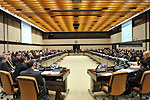Armament Directors advance key NATO capabilities initiatives
Armament Directors from the 26 NATO member countries moved forward on three key NATO capabilities initiatives: Alliance Ground Surveillance, Missile Defence and the Defence Against Terrorism Programme of Work at the biannual Conference of National Armament Directors (CNAD) held at NATO HQ on 24 April 2008.
During the meeting, the officials responsible for defence procurement in NATO member countries examined issues discussed at the recent Bucharest Summit and developed plans to move forward on a number of issues in preparation for NATO's 60th Anniversary Summit next year.
Improving NATO’s ‘eyes in the sky’
NATO’s Alliance Ground Surveillance (AGS) system consists of a mix of manned and unmanned airborne radar platforms that can look down on the ground and relay data to commanders, providing them with ‘eyes in the sky’ over a specific area.
The Supreme Allied Commander Europe (SACEUR), General John Craddock, emphasized the need for ‘timely delivery of Alliance Ground Surveillance,’ which will further strengthen information superiority through network enabled capabilities that link NATO and national systems.
The participating countries re-stated their commitment to acquire a state-of-the-art AGS system and agreed to share costs, paving the way for the preparation of a Request for Proposal to industry. A Programme Memorandum of Understanding will also be prepared for national staffing and signature, and a charter for the creation of an AGS management organization will be circulated for approval.
Missile defence
Good progress was made on the Active Layered Theatre Ballistic Missile Defence System (ALTBMD) capability. The system, which is designed to protect troops deployed on missions from short and medium range ballistic missiles, is scheduled to deliver an initial operating capability (IOC) before the end of 2011. Armaments Directors recognized a major programme milestone achieved earlier this year—opening of the integration Test Bed at the NATO C3 Agency in The Hague—ahead of schedule and on budget.
On the issue of territorial missile defence, the Armament Directors reviewed progress which led to a report to Heads of State and Government at Bucharest. At that NATO Summit, new taskings were received which will become CNAD's contribution to discussion and a possible decision at the 2009 Strasbourg/Kehl Summit on linking current NATO missile defence efforts with the planned deployment of European-based United States missile defence assets and options for a comprehensive missile defence architecture to extend coverage to all Allied territory and populations not otherwise covered by the US system.
Defence against terrorism

NATO's Assistant Secretary General for Defence Investment, Peter Flory
The Armaments Directors also focused on ways in which NATO is developing new, cutting-edge technologies to protect troops and civilians against terrorist attacks.
These technologies are aimed at preventing the kinds of attacks perpetrated by terrorists, such as suicide attacks with improvised explosive devices (IEDs) and rocket attacks against helicopters.
The Defence Against Terrorism Programme of Work (DAT PoW) reached several important crossroads:
- the Defence Against Mortar Attack (DAMA) initiative will pass from Netherlands to Norway leadership in May;
- the Precision Airdrop initiative is reaching maturity and could help NATO military authorities address the serious shortfall in helicopters;
- the Counter IED initiative has made considerable progress with the development of an IED database to facilitate detailed analysis of incidents, an integration tool to improve the performance of existing technologies, and a very innovative solution to prevent member countries' electronic jammers from attacking each other, rather than the IED;
- Canada announced its plans to launch work on Non-Lethal Capabilities, involving interested non-NATO countries.
Other developments included CNAD's contribution to addressing helicopter shortfall in Afghanistan, progress on the implementation of a Joint Intelligence, Surveillance and Reconnaissance (JISR) capability for the International Security Assistance Force (ISAF), and options on how to improve trans-Atlantic defence industrial co-operation.
Finally, National Armaments Directors discussed CNAD's possible contributions to NATO reform in areas such as the defence planning review, a more capability-based committee structure, and closer relations with some of the 13 NATO agencies.

